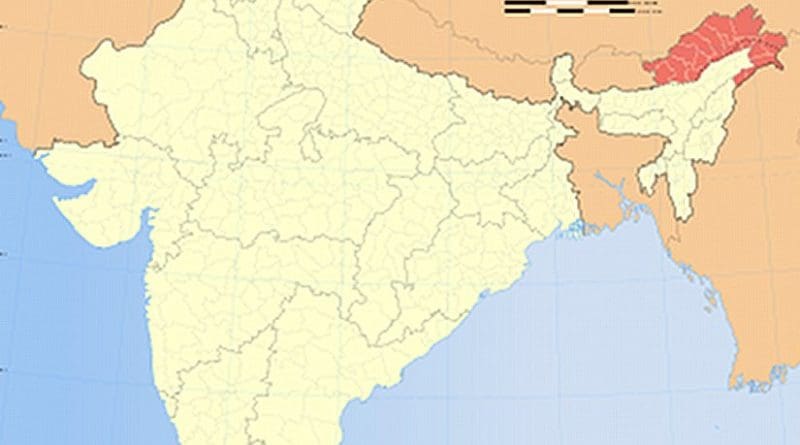China’s Response To India’s Military Upgrade In Arunachal Pradesh: Classic Case Of ‘Security Dilemma’ – Analysis
By Manohar Parrikar Institute for Defence Studies and Analyses (MP-IDSA)
By Namrata Goswami
Given the China’s continued aggressive claims over Arunachal Pradesh, India has taken a critical strategic decision in October this year to deploy the Brahmos supersonic cruise missile which has a flight range of 290 km in the eastern sector to strengthen its defense posture vis-à-vis China. A five year expansion plan to induct 90,000 more troops and deploy four more divisions in the eastern sector is also underway. Already, there are 120, 000 Indian troops stationed in the eastern sector, supported by two Sukhoi 30 MKI squadrons from Tezpur in Assam. The distance from Tezpur to Tawang is 345 kms and from Tawang to the Line of Actual Control (LAC) is 60 kms. The Sukhoi 30 MKI will cover the distance in less than 15 minutes given its cruise speed of 860 mph (1380 km/h) at 32780 ft (10000 m) and 1350 kmph over sea level.
In response to the upgraded Indian military posture in Arunachal Pradesh, a recent publication in the People’s Liberation Army’s official newspaper, PLA Daily, stated that India’s bold military moves in the eastern sector are motivated by a desire to “contain China” since India views China as a de facto competitor in Asia. The PLA Daily article further argued that in alliance with the West (read the US), India is aiming to balance China by carrying out the largest military upgrade since 1962 in the eastern sector.
This PLA view is rather ironical to say the least. Since 2006, it is China that has tried to undercut the rise of India in Asia by upping the ante in Arunachal Pradesh, much before India engaged in its current military upgrade in the eastern sector. In November 2006, just days before Chinese Premier Hu Jintao’s state visit to India, Chinese Ambassador to India, Sun Yuxi, stated that the whole of the state of Arunachal Pradesh is Chinese territory. In May 2007, China denied visa to Ganesh Koyu, an Indian Administrative Service (IAS) officer from Arunachal Pradesh, who was to be a part of a 107 IAS officer study visit to Beijing and Shanghai. China pointed out that Koyu is a Chinese citizen since he belongs to Arunachal Pradesh and hence could visit China without a visa. In June 2009, China again tried to block India’s request for US$ 2.9 billion loan from the Asian Development Bank (ADB) as the request included US$ 60 million for flood management, water supply, and sanitation project in Arunachal Pradesh. This was the first time that China sought to broadcast its claim on Arunachal Pradesh in a multi-lateral forum. Subsequently, in October 2009, China expressed deep dissatisfaction when Prime Minister Manmohan Singh visited Arunachal Pradesh as part of an election campaign for the state assembly elections. In November 2009, China openly protested the Dalai Lama’s visit to Arunachal Pradesh.
China has also upgraded its own military presence in Tibet very close to the LAC in Arunachal Pradesh. The 2010 US Department of Defense Report to Congress indicated that China replaced its old liquid fueled, nuclear capable CSS-3 intermediate range ballistic missile with “more advanced CSS-5 MRBMs” and vastly improved its border roads in the eastern sector bordering India for PLA movement. Intercontinental missiles such as the DF-31 and DF-31A have also been deployed by China at Delingha, north of Tibet. On the border with India, China has deployed 13 Border Defence Regiments amounting to around 300,000 PLA troops. Airfields have also been established at Hoping, Pangta and Kong Ka respectively, along with the existing six airfields in the Tibetan Autonomous Region for supporting fighter aircrafts and to enhance PLA’s airlift capability.
The situation, as its stands today in India’s eastern sector, has come full circle. In the first place, China signals aggressive intent with regard to Arunachal Pradesh. It lays claim to the entire state of Arunachal Pradesh and has been upgrading its military presence in Tibet. As a counter-response, India upgrades its military infrastructure in Arunachal Pradesh to deter plausible Chinese aggression. China views the Indian military upgrade as a response to China’s rise in Asia forgetting that its own aggressive posture and military upgrade since 2006 has provoked the Indian response. The consequence of all this is a classic “security dilemma” requiring deft handling as any wrong signaling of intent or offensive military posture from either side could lead to conflict escalation.
Given the current situation, India has two realistic policy options:
First, India must clearly state that while it has no offensive military desires, or a wish for any armed conflict with China, its defensive capabilities are optimal to deter any Chinese military move into its territory. Building military infrastructure in Arunachal Pradesh adds credibility to the country’s conventional ‘deterrence’ posture. Through such defensive postures, India ‘signals’ not only its commitment to defend Arunachal Pradesh in case of a Chinese military invasion but also ensures that China clearly understands that India’s defensive force structures are credible.
Second, India should continue to negotiate with China on the border dispute within the framework Agreement signed between the two countries on April 11, 2005. In this context, the establishment of border management institutional mechanism towards the end of this year will be beneficial in resolving difficult issues pertaining to the disputed border in a structured way, thereby creating institutional memory for future reference.
The India-China territorial dispute in the eastern sector, pending resolution for decades together, is not an intractable issue. It can be resolved. While India’s current moves to defend its territory against Chinese aggression is warranted, the best way forward to resolve the issue with China is through a mechanism of dialogue and confidence-building.
Originally published by Institute for Defence Studies and Analyses (www.idsa.in) at http://www.idsa.in/?q=idsacomments/ChinasResponsetoIndiasMilitaryUpgradeinArunachalPradesh_ngoswami_181111


Great stuff!